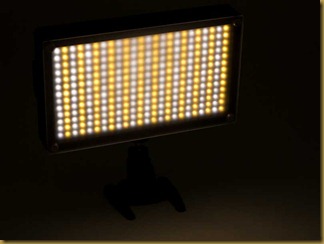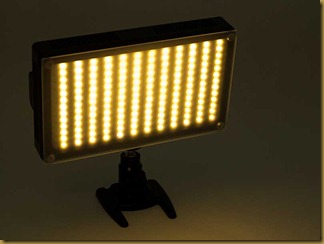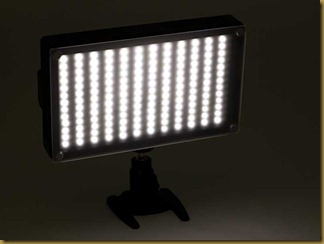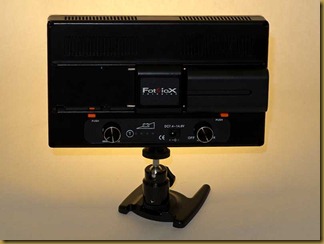The Fotodiox LED312AS is an LED light with 312 bulbs. Half the bulbs glow white to simulate daylight; half glow yellow to simulate incandescent (tungsten) bulb light.
At full tungsten setting, the daylight LEDs do not glow at all (photo above taken at Daylight white balance to emphasize tungsten lighting effect).
At full daylight setting, the tungsten LEDs do not glow at all. (Above picture shown using Daylight white balance.) Color and intensity are controlled by two independent dials on the back of the light. The net effect is said to be a controllable color range between 3200K and 5600K and brightness up to 6580 lux. The LED output panel measures roughly 6-3/4 x 3-3/4 inches.
I bought the Fotodiox LED312AS on the recommendation of Kirk Tuck in a post on The Online Photographer about LED lighting. Kirk writes regularly about the advantages of LED lighting; in fact, he has a book titled “LED Lighting” that I found very useful. After posting his recommendation for the Fotodiox LED312AS, Kirk posted a brief follow-up on his blog.
The LED312AS comes in a nice kit consisting of light, a small swivel stand, a clearish diffusion panel, two NP-F550 Li-ion batteries and a battery charger all neatly stowed inside a zippered nylon case.
The LED312AS needs only one battery to work but two batteries can be mounted on the light. Continuous working time is said to be 100 minutes (I assume this is with both batteries.) The little ballhead swivel to hotshoe mount is usable but a better configuration will be to mount the LED312AS to an umbrella style mount. Picture above is shown with Daylight white balance to emphasize that the LED312AS was set for tungsten light.
Kirk Tuck reports that nearly all LED lights have a slight greenish tint and recommends a 1/4 magenta gel to be placed over the light. My experience, based on working with RAW files, is the same. I don’t have a magenta gel but will be getting one – especially to work with video.
Speaking of video, my first attempt to use the LED312AS was a bust. I attempted to use it to provide a bit of fill light in a shady area on a bright day. The LED312AS could not be placed closer than about 8 feet from the subject and it was relatively ineffective. I resorted to bouncing sunlight with a reflector. My guess is that at least two, probably four, LED312AS were necessary for that setting.
I like continuous lighting because of the immediate feedback on placing the lights. The LED312AS is small, lightweight and battery powered so I expect to use it a lot.
(All above photos taken with the G1X. Accessory close-up lenses were not necessary.)




No comments:
Post a Comment